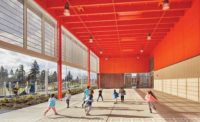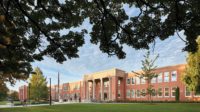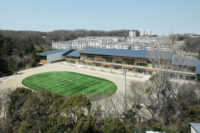With a reputation for liberal politics, picturesque landscapes, and a relaxed dress code, 28-square-mile Bainbridge Island in Washington's Puget Sound is viewed by many as an idyllic spot to raise a family. Once dominated by logging and ship building and, later, agriculture, the island has evolved into an affluent bedroom community of Seattle, just a 35-minute ferry ride away. Given its tight control on development and its promotion of green space, it is no surprise that the island—which prides itself on its small-town charm and progressive values—has high expectations for its schools, which reflect and promote the way of life here.
Wilkes Elementary, which has 382 students, com-municates its open vibe from the moment parents drop off their children at the covered porch that serves as the entry. The welcoming space prompts casual interactions among parents, students, and staff by inviting them to linger, and announces the value placed here on community and family participation in the education process.
To break down the building's scale, the architects organized the plan as a series of bars separated by courtyards. Within each wing, classrooms are linked by a corridor that widens into a “shared learning space,” where activity can spill out and special programs are hosted. On a recent morning, these areas buzzed quietly: children read independently while a volunteer set up an art project. “We wanted to encourage collaboration by getting not only kids, but also teachers, out of the classroom,” says Mahlum managing partner Gerald (Butch) Reifert. “We thought of the classroom as a house, and the corridor and shared learning space as the porch.” Two long hallways, running north to south, create a circulation ring that fosters interaction among the grades. “The building knits into the land,” notes project designer JoAnn Wilcox, referring to the finger-like volumes that reach out into the site, which the team regraded into a gentle slope. “The overlay here is that teaching is about the whole child, and the idea of learning from play.” To blur the lines between educational and recreational spaces while creating ample sight lines, the architects used extensive glazing, providing views between interiors and out to rain gardens, courtyards, and play areas while filling the school with daylight, even on a gloomy fall afternoon. Some people fear transparency, notes Reifert. “But we believe the opposite: the more transparent, the safer.” The glass has other benefits, Belt adds. “Kids view the whole area as a classroom and know adults can see them every minute. They're more independent, because we can let them be.”
The project added a cafeteria that doubles as a performance space and an enlarged gymnasium, which meets standards for competitive use. These facilities, along with the library, occupy the building's east side, and are accessed by a public hallway with its own entry. Outside school hours, they can remain open and be used by the local basketball league or church groups. While creating a community amenity for the island's north end, which has no town center, these additions have surprising effects, too. For example, a separate cafeteria frees teachers from overseeing meals in their classrooms, points out Tamela J. Van Winkel, the district's director of facilities and capital projects. This buys 15 minutes a day, she says, “which adds up to eight days a year.”
Dignified materials, like dark-fired brick, concrete, and wood are complemented with splashes of color on flooring and textiles—hues inspired by a student project on Matisse cutouts. These choices lend the school a serious yet joyful air without resorting to the condescending primary palette so often employed. And sustainable features abound, from nontoxic finishes to 100 percent on-site stormwater infiltration and waste-water treatment, heat recovery, and a hybrid radiant heating system with 45 geothermal wells.
Since it was founded in 1938, Mahlum has designed dozens of schools. “We look at each project as a template,” says Reifert. “There are always lessons learned. We take many ideas and move them forward.” But rather than applying a cookie-cutter approach whereby design elements are merely recycled, Wilcox notes, “We bring values. For example, we ask, 'How do we create connectivity?' Or quiet—how do we create the building as a backdrop for the life, the color, and the activity that students bring?” In the end, it's about place-making. “You layer on educational design principles, but the goal is to create a place that is whole—bigger than the sum of its parts.”
People
Formal name of building:
Location:
Completion Date:
Gross square footage:
Total project cost:
Total construction cost:
Client:
Owner:
Architect:
Personnel in architect's firm who should receive special credit:
Interior designer:
Engineers:
Consultant(s):
General contractor:
Photographer(s): Size: 64,450 square feet Construction cost: $21.7 million Completion date: September 2012 |
Products
Exterior cladding
Roofing
Windows
Glazing
Doors
Interior finishes
Furnishings
Lighting
Conveyance
Plumbing
Energy
Other unique products that contribute to sustainability: |















Post a comment to this article
Report Abusive Comment